Probably everyone knows the Terracotta Army of Xi’an. The painted warriors and horse-drawn chariots from the tomb of Emperor Qin Shihuangdi are world-famous, and there are often traveling exhibitions to Germany and other countries. The discovery fits perfectly into the image that China would like to convey to the outside world, as it reflects a powerful empire under one ruler.
Far less famous are the finds at the Sanxingdui ruins. They are believed to be the remains of the Shu Kingdom, which was at least 4,800 years old and existed for more than 2,000 years. However, these discoveries also challenge the image of a unified Chinese identity, writes Fabian Peltsch. Nonetheless, President Xi Jinping is personally pushing for the recognition of Sanxingdui as a UNESCO World Heritage Site. After all, the national myth of a diverse and peace-loving trading partner fits well with China’s narrative in the era of the New Silk Road.
Different narratives about how the world should best function are also evident at G7 and BRICS. The alliances held summits at the end of June. Frank Sieren looked at the final declarations of the two events and concludes: The G7 is on the defensive in some respects, while the BRICS countries argue in a more inclusive manner. That is one view. Because it also shows: The BRICS declaration lacks substance because it represents a minimal compromise. The G7, however, stands surprisingly united.

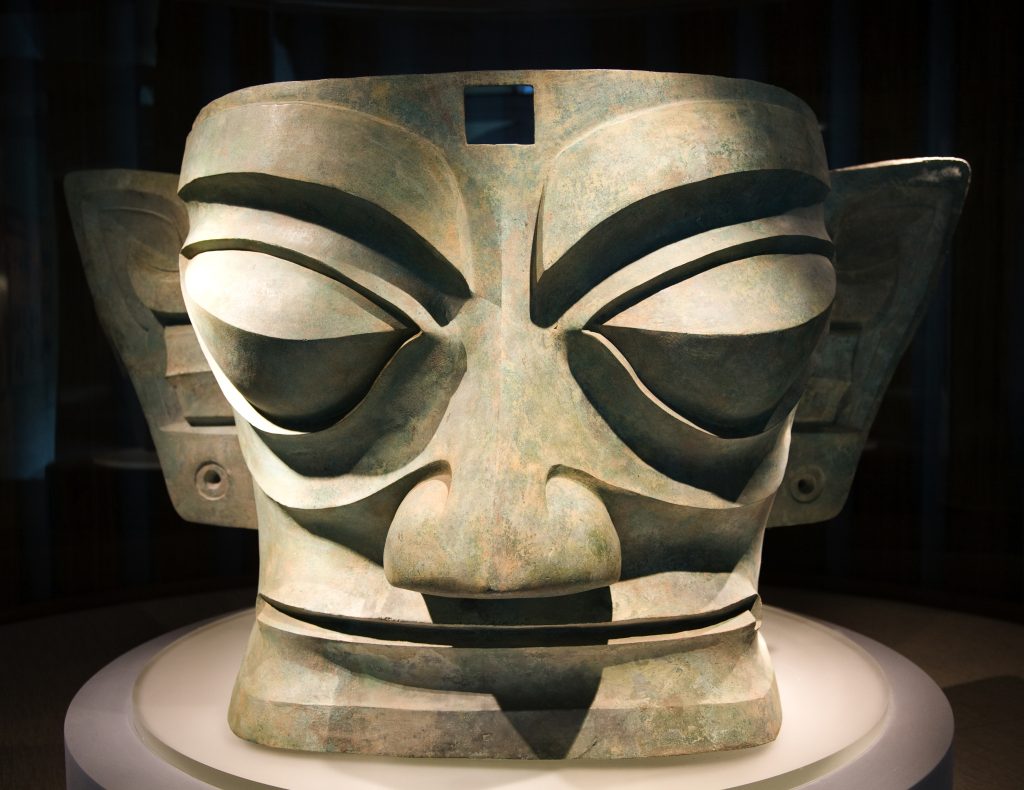
The archaeological discoveries of Sanxingdui resemble something out of a surreal horror movie: Gigantic, boxy heads. Creatures with stalk eyes. Hybrid beings with snake bodies and bird legs. On top of that, a four-meter-tall bronze tree, with mysterious birds perched on its branches. These dramatically illuminated artifacts can be admired at the Sanxingdui Museum in the northeastern part of the excavation site, about 40 kilometers from Sichuan’s capital, Chengdu.
A mysterious culture sank them some 3,000 years ago in eight sacrificial pits, six of which have been uncovered since their discovery in the mid-1980s. At the end of March, archaeologists presented more objects to the public, including an altar and a chest in the shape of a turtle shell. “Spectacular finds,” as Prof. Dr. Maria Khayutina, a sinologist and expert on pre-imperial China at LMU Munich, tells China.Table. “Unfortunately, the Western world is quite uninterested in discoveries outside its cultural sphere. What is not familiar is often simply ignored.”
In China, on the other hand, live coverage of the excavations was broadcast for days this spring. Sanxingdui has long been part of local pop culture. At this year’s CCTV New Year’s Gala, the largest television event in the world, a choreography with Sanxingdui holograms was performed. On Chinese e-commerce sites, sneakers with Sanxingdui motifs can be purchased, and T-shirts, pen holders, popsicles, and emojis are also available in the shape of the distinctive bronze heads. In 2016, China’s movie industry even announced a blockbuster co-produced by US star director James Cameron, in which a visitor from a foreign land learns about Sanxingdui culture. The leading role in “The Guest of Sanxingdui” is to be played by none other than Arnold Schwarzenegger, who was also signed on as an international ambassador for the archaeological site.

In fact, not only Chinese historians consider Sanxingdui to be one of the most important archaeological discoveries of the 20th century – more important even than the terracotta army from Xi’an. At the same time, these objects seem so strange that for the most part they cannot be categorized with other discoveries from China. Who were the creators of these strange works? What was their purpose? Written documents or human remains are absent, making the matter even more mysterious. Last year, the state-run Global Times newspaper even felt compelled to publish an article ruling out an extraterrestrial origin of the Sanxingdui civilization.
For a long time, the consensus among China’s historians was that Chinese civilization developed along the middle valley of the Yellow River. In the 1920s, archaeologists unearthed remains of the last capital of the Shang Dynasty in the central excavation sites of Anyang. Here they also discovered a large part of the famous oracle bones, which are considered the first evidence of Chinese writing.
During the excavations, civil war raged, and shortly after, the Japanese invaded. Both fueled the longing for a unified Chinese identity. Neolithic excavation sites along the Yangtze River or bronze finds in Gansu had already shaken the theory of the cradle of civilization in the heart of China after the Cultural Revolution. But it was the highly refined bronze objects in Sanxingdui, separated by mountain ranges, that turned the old world view upside down.
According to the official Chinese version, the Sanxingdui pieces are relics of the Shu kingdom, which is said to have lasted for more than 2,000 years. However, the Shu are more “Mystery than History”. “Shu is known as the name of a kingdom that existed in what is now Sichuan 1,000 years later,” Khayutina says. “Whether there was a direct connection between it and Sanxingdui, I don’t think has been definitively clarified.” Some scholars argue that the people of Sanxingdui maintained ties with cultures in Burma, Central Asia and India. Amateur scientist Su San even states in two books that Sanxingdui society descended from the Red Sea. The evidence for this, however, is as thin as the claim that Sanxingdui had been in active contact with aliens.
Chinese historians are now mainly looking for commonalities in Sanxingdui. Professor Zhao Hao of Peking University, who is involved in the excavations at Pit No. 8, told state television last week that basic motifs of Chinese culture, such as dragons or the Zun vessels typical of the Shang Dynasty, were also found at Sanxingdui. “The idea of a culture in which different influences come together fits the concept of a modern nation much better than the old world view,” Khayutina explains. And indeed, in today’s China, Sanxingdui is seen above all as proof of how diverse Chinese culture has flourished outside its supposed center.
President Xi Jinping, who is personally pushing for the recognition of Sanxingdui as a UNESCO World Heritage Site, knows the power of a national myth that reinforces the image of a diverse and peace-loving trading partner in the era of the New Silk Road (China.Table reported). State news agency Xinhua quoted him as saying in October 2021 that the Sanxingdui excavations “reveal the origin and evolution of the Chinese civilization, its glorious achievements and great contributions to human civilization.”
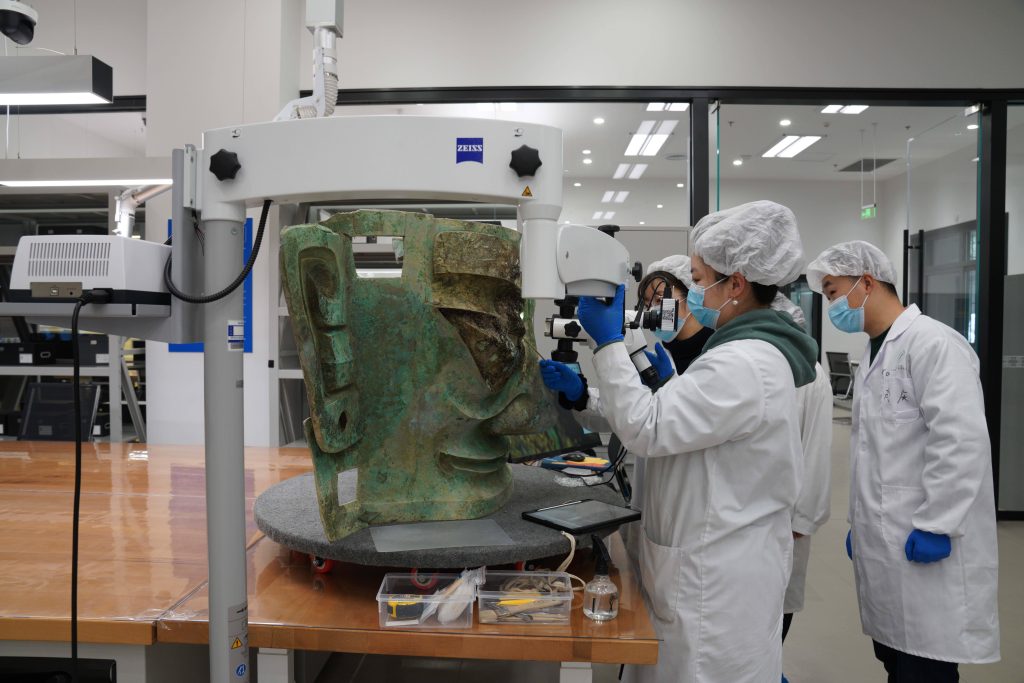
Also thanks to Xi, China is currently experiencing a “golden age of Chinese archaeology,” writes the South China Morning Post. While the Sanxingdui discoveries were still hauled away on bicycles in the 1980s, the excavation site is now one of the most modern in the world. More than 120 scientists from all over the country work here. Laboratories have been built above the pits, where humidity and temperature are precisely balanced. The archaeologists wear protective suits. Not a single hair or skin flake must be allowed to falsify the radiocarbon and DNA examinations.
A new 30,000-square-meter exhibition hall for the most recent finds is also in the planning stages. “China values its cultural heritage and also instrumentalizes it,” Khayutina says. “Bombastic museum facilities that Europe can only dream of are opened at every significant site.”
Excavations in the last remaining sacrificial pits are expected to be finished early next year. However, research on the Sanxingdui culture is just beginning, says Wang Wei, a historian at the Chinese Academy of Social Sciences in Beijing. “The next step is to look for larger architecture where, for example, the last altar found might have stood.” Then, perhaps, the pressing mystery for Chinese historians of how this highly advanced civilization could so suddenly disappear off the face of the earth will be solved.
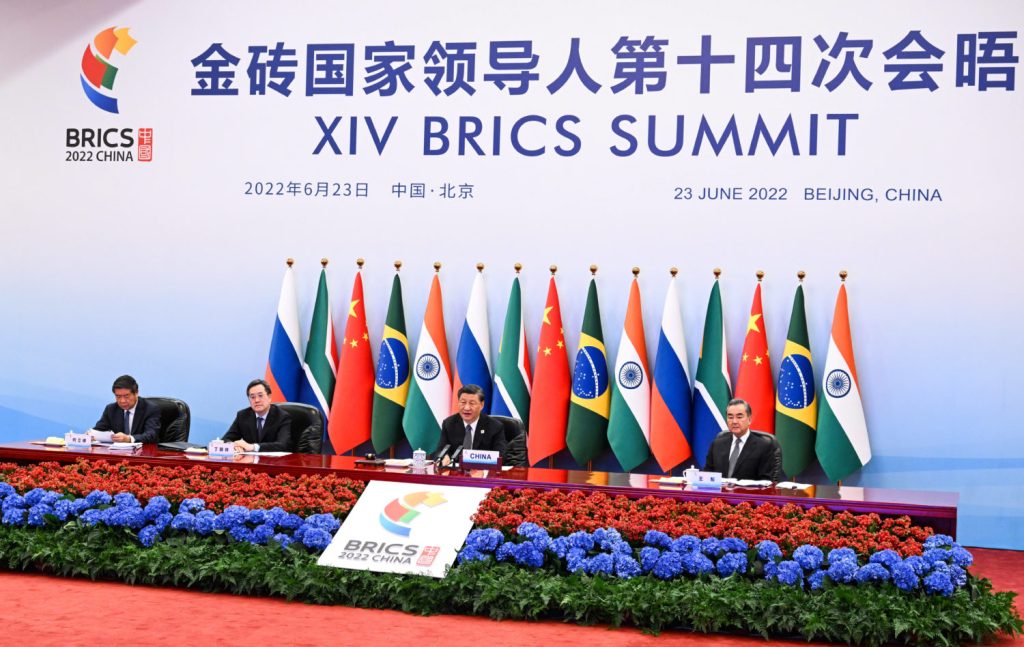
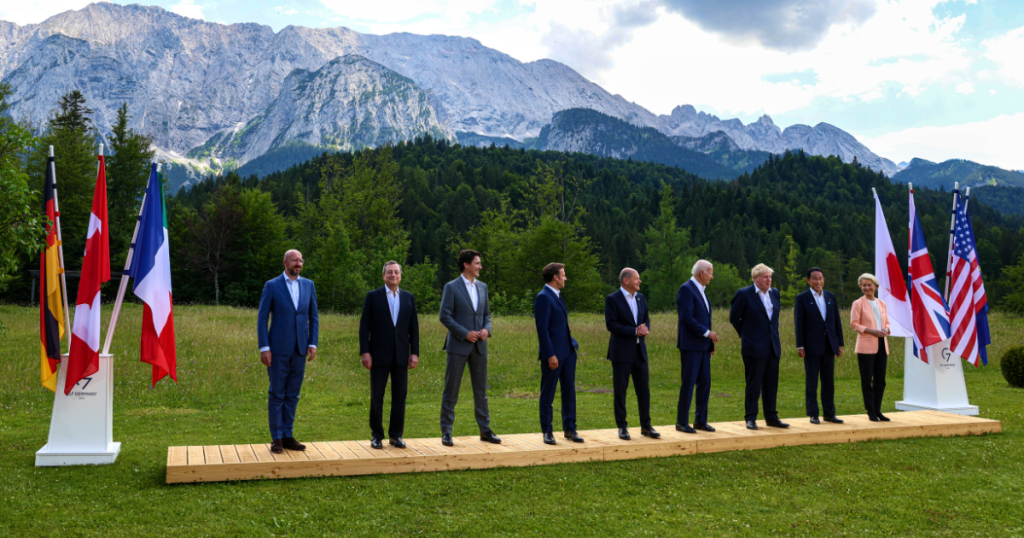
Final declarations of summit meetings have a special significance. While politicians of individual nations can adopt their positions more freely, a consensus must be found in the final declarations of a group of nations. Views have to be negotiated and are therefore more balanced, robust and closer to reality than national positions.
In these times of crisis with the Covid pandemic and the Ukraine war, it is particularly difficult to find consensus because positions are radicalizing. At the same time, it becomes much more apparent in which direction the respective groups are leaning. That is why it is worth taking another close look at the final declarations of the G7 and BRICS with a little distance. The fact that they took place almost in parallel this time makes it easier to compare them. The participants’ level of information was the same.
One thing is obvious: The emerging BRICS countries have a fundamentally different view of the world than the established G7 countries. The G7 was founded in 1973. They represent highly developed, in part already stagnating industrial nations from three continents, the democracies Germany, France, England, Italy, Japan, Canada and the United States.
BRICS, on the other hand, was founded in 2009 and represents emerging countries from five continents, some of which are still growing rapidly. Its members are Brazil, Russia, India, China, South Africa. They include both democracies and dictatorships.
Although the G7 countries are generally no longer growing as strongly (in 2021, the figure was 1.4 percent), with 10 percent of the global population they still create a 45 percent share of the global economy. However, this share is steadily declining. Thirty years ago, it was still over 70 percent.
By contrast, the BRICS countries represent 40 percent of the global population, but currently only account for 25 percent of the global economy. However, this share is climbing sharply because the BRICS are growing faster. In 2021, growth was 5.6 percent.
In some respects, the G7 is on the defensive. The pressure to defend is greater. This is very noticeable in the G7’s final declaration. The focus is on Russia’s behavior. At the very beginning, it says the G7 are standing “standing in unity to support the government and people of Ukraine” and oppose “President Putin’s regime for its unjustifiable war of aggression”. So, as a side effect, the invasion gives the G7 a common enemy uniting them. The United Nations is not even mentioned here. Instead, the talk is about a “rules-based multilateral order”. In this passage, China does not play a role.
Surprisingly, China is not mentioned in the following paragraph on climate change either, only in the paragraph on the “Global Economy and Finance,” and there first as an unyielding creditor of developing countries. The G7 calls on China to “contribute constructively to the necessary debt treatments as requested”.
Then in paragraph 5, under the heading “Foreign and Security Policy,” the focus is again on China: “There is no legal basis for China’s expansive maritime claims in the South China Sea.” The G7 also urge China to “respect navigational rights and freedoms enshrined in UNCLOS (United Nations Convention on the Law of the Sea)”. However, it was never even signed by the United States.
That it was “necessary to cooperate with China on shared global challenges” is mentioned only in passing by the G7 countries. It is much more important to them to urge China “to press Russia to immediately (…) abide by the relevant resolutions of the UN General Assembly and stop its military aggression.”
The situation in Hong Kong is also mentioned: Beijing should “honour its commitments made in the Sino-British Joint Declaration and the Basic Law, which enshrine rights, freedoms and a high degree of autonomy for Hong Kong”. As for China’s role in the global economy, the G7, wants to “build a shared understanding of China’s non-transparent and market-distorting interventions and other forms of economic and industrial directives.”.
The G7 countries intend to take coordinated action “to ensure a level playing field for our businesses and workers, to foster diversification and resilience to economic coercion, and to reduce strategic dependencies”. They express to be “gravely concerned about the human rights situation in China” and want to continue “promoting universal values”. Therefore, they call on China to respect human rights, including in Tibet and Xinjiang, “where forced labour is of major concern to us”.
So the G7’s angle is: Our rules apply and anyone who doesn’t follow them will be pressured and not allowed to join the game. They dish it out to all sides. In the communiqué, the G7 also criticizes North Korea, Myanmar, Iran, Afghanistan, Libya, Yemen and Syria.
The BRICS Declaration, by contrast, adopts a different tone. At no point is the document explicitly directed against other countries, not even against the G7 or the USA. Rather, its tenor is that everyone should find a consensus with one another, and the UN should play a pivotal role in this process. The five BRICS countries do not emphasize who they are for and who they are against, but rather their own common global goals: “mutual respect and understanding, equality, solidarity,” but also “openness, inclusiveness, and consensus“. While these are goals that are partly trampled on by their own member countries, they represent an acceptable direction for the future to agree on.
It is only in the third paragraph, under point 21, that international interaction is addressed at all: The BRICS “respect the sovereignty and territorial integrity of all states.” They call for disputes to be solved peacefully through “dialogue and consultation”. Regarding the Ukraine conflict, the countries do not want to snub their member Russia, but support under point 22 “talks between Russia and Ukraine”. The humanitarian situation in and around Ukraine “was discussed”. BRICS supports “efforts of the UN Secretary-General, UN Agencies and ICRC to provide humanitarian assistance in accordance with the basic principles of humanity”.
This means that the BRICS countries tend to adopt a more inclusive line. The G7 countries, on the other hand, seem to be more restrictive and exclusionary. The position of the BRICS reflects the positions of most countries around the world rather than those of the G7. This is evident, for example, by the fact that 170 of 193 nations do not support sanctions against Russia. The positions of the BRICS countries will likely play a greater role in the years and decades to come as their economic power increases, while the G7 will continue to lose its influence.
The city of Beijing has imposed a vaccination mandate for public places. Starting July 11, visitors to high-traffic public places, such as after-school educational institutions, libraries, museums, cinemas, indoor sports facilities, Internet cafes, and event venues, will be required to present at least one vaccination against the Coronavirus. Individuals who cannot receive a vaccination for medical reasons are exempt from the measure. This is the first time a Chinese city has introduced mandatory vaccination. Restaurants and public transportation are exempt. In the city of Beijing, 97.7 percent of the adult population was vaccinated as of September last year, Reuters reported.
Mandatory vaccination also applies to medical staff working in nonprofit facilities, package and express delivery services, and conference attendees, Bloomberg reports. These groups will even be required to present a booster vaccination to be allowed to continue working normally. Again, medical exemptions apply.
The Deputy Director of the Municipal Health Commission, Li Ang, also urged people over the age of 60 to be vaccinated against the virus. This group is considered to be particularly vulnerable. According to Li, caregivers in nursing homes and visitors should receive a booster vaccination. Beijing’s health code, which the city uses to monitor people’s movements, is to be updated to better display the vaccination status. nib
The United States urges the Netherlands to ban exports of machines for the production of chips. Until now, the USA was content with an export ban on high-tech machines. Now, the Dutch government is also expected to order local global market leader ASML to stop selling older technologies to the People’s Republic, Bloomberg reports.
According to informed circles, the USA wants to ensure that ASML is not allowed to export older lithography equipment for chip production. The chips produced with these machines are still used in cars, robots and smartphones. An export ban would hit Chinese chipmakers hard. The Dutch government still has to agree with the US request. The US government is also exerting pressure on Japanese agencies.
The company Tokyo Electron is another important supplier for the chip industry. After the US requests to the Netherlands were made public, China accused the US of “technological terrorism,” according to Zhao Lijian, spokesman for the Foreign Ministry. He left open whether China would take countermeasures. nib
Volkswagen plans to hire several thousand software engineers in China. This is according to statements made by VW CEO Herbert Diess. The digital transformation was the most important upheaval facing the group, he said. Self-driving cars, entertainment and digital gadgets would be a major challenge for the auto industry. In China, Volkswagen faces the task of adapting to the local wishes of its customers, who often have different ideas about things digital than Western consumers.
In an interview with the German newspaper Sueddeutsche Zeitung, Diess stated that there were no plans to close the controversial plant in Xinjiang. According to Diess, local partner SAIC must “ensure” that “we do everything we can at our minority-owned plant so that there is no discrimination there.” Diess expressed his confidence that the situation of minorities in Xinjiang would improve if VW kept the site. “I therefore also want to travel there myself as soon as possible,” Diess announced. nib
Pope Francis hopes to renew the controversial agreement with the People’s Republic of China on the appointment of bishops – though there are still coordination problems, the pope Reuters. “The agreement is good, and I hope it can be renewed in October,” the pope added.
Cardinal Secretary of State Pietro Parolin is on duty as a negotiator with Beijing, Francis explained. Parolin is “a man of high diplomatic standing” and knows how to move in China. “Faced with a closed situation, one must seek the possible, not the ideal, path. Diplomacy is the art of the possible and making what is possible become a reality,” Francis said.
The provisional agreement, which entered into force in October 2018, was extended for the first time in 2020 for another two years. The deadline expires in the fall. The agreement between Beijing and the Vatican, the wording of which is being kept under wraps, has been criticized for not improving the lives of Catholic Christians in the People’s Republic. rtr/ari
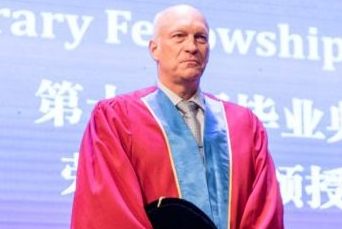
Even today, Hans van Ess clearly remembers how the scents, so foreign to him at the time, assailed his nose. He stood next to his father, the islamologist Josef van Ess, in the bazaar in Beirut and saw the spices piled up in heaps on tables along the street. Cardamom, cloves, curry, saffron and allspice – a sea of colors. All around the boy, scurrying people and the buzz of haggling merchants. An experience that would leave a lasting impression on him.
Hans van Ess is now 60 years old and a sinologist at Ludwig Maximilian University of Munich. He is also President of the Max Weber Foundation for the Promotion of Research. He focuses on Confucianism, Chinese historiography, and Central Asian studies with reference to China and Mongolia.
On his first trip to China, van Ess was astonished. Four semesters of sinology should be enough. He thought. He traveled across the country for two months with two Chinese and a German. What was planned as an adventure, however, turned into a tour de force. “At first, nothing worked. I only understood maybe 20 percent of what I heard. And speaking was out of the question,” says van Ess. In the evening, he was completely exhausted. That taught him humility.
The grammar was not difficult at all. But the Chinese language draws a lot from proverbs that relate to ancient Chinese. “You need a deeper understanding of Chinese history to really learn the language,” he says. After earning his master’s degree, van Ess moved to Shanghai. It eventually took him nine months to settle in.
Due to the still harsh Covid restrictions, van Ess has not been to China for a long time. The last stay was a research visit to Beijing in 2019. On top of that, there is the long-standing tension between Germany and China. The US is on one side, China on the other. Wedged in between is Germany. “A relatively unpleasant situation,” says van Ess. It’s up to politicians to find compromise solutions, he says. But it is almost impossible to achieve a satisfactory outcome for both sides.
“Anyone who wants to visit China should forget everything he or she has read about it,” says van Ess. He recommends Mo Yan, the first Chinese winner of the Nobel Prize for Literature. Visitors should also venture out of the big cities. That’s what van Ess does on many of his visits. When he is in Beijing, he always likes to drive into the surrounding countryside for a few days. There, visitors can gather completely different impressions and get to know a different China. Tim Winter
Maria Kipfelsberger is the new Chief Financial Officer at Airbus Helicopters in Qingdao. Kipfelsberger was previously Program Controller at Commercial Helicopter and Development in Donauwoerth.
Wei Kai Lee is the new Head of Asia Pacific at Swiss investment house Vontobel. His predecessor was Ulrich Behm. Lee works from Singapore.
Angus Hui is moving from investment advisor Schroders to Fullerton Fund Management. For the job change, he moves from Hong Kong to Singapore. At Fullerton Fund Management, he takes over the Fixed Income division.
Is something changing in your organization? Why not send a note for our staff section to heads@table.media!
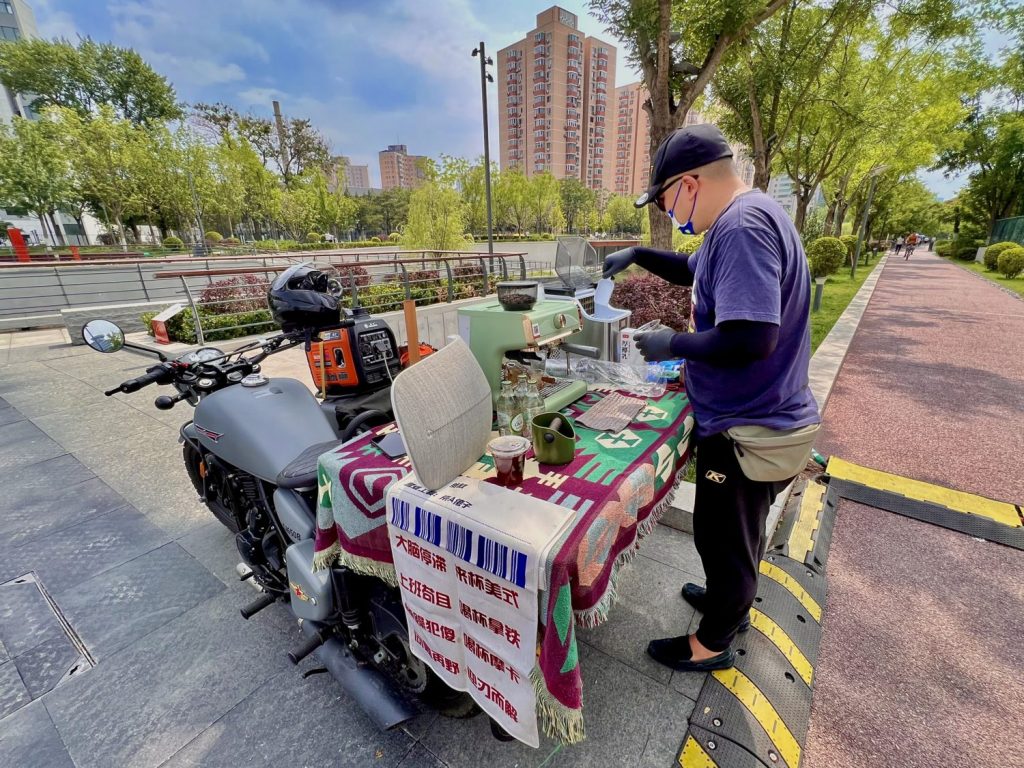
Mobile street café: Since the beginning of the Covid pandemic and the resulting closure of cafés and restaurants, resourceful restaurateurs have developed ways to continue bringing coffee to their customers. The mobile coffee shop is transported on a moped or tricycle: Folding table, portafilter, mug, ice machine and a small power generator – ready is the coffee mobile.
Probably everyone knows the Terracotta Army of Xi’an. The painted warriors and horse-drawn chariots from the tomb of Emperor Qin Shihuangdi are world-famous, and there are often traveling exhibitions to Germany and other countries. The discovery fits perfectly into the image that China would like to convey to the outside world, as it reflects a powerful empire under one ruler.
Far less famous are the finds at the Sanxingdui ruins. They are believed to be the remains of the Shu Kingdom, which was at least 4,800 years old and existed for more than 2,000 years. However, these discoveries also challenge the image of a unified Chinese identity, writes Fabian Peltsch. Nonetheless, President Xi Jinping is personally pushing for the recognition of Sanxingdui as a UNESCO World Heritage Site. After all, the national myth of a diverse and peace-loving trading partner fits well with China’s narrative in the era of the New Silk Road.
Different narratives about how the world should best function are also evident at G7 and BRICS. The alliances held summits at the end of June. Frank Sieren looked at the final declarations of the two events and concludes: The G7 is on the defensive in some respects, while the BRICS countries argue in a more inclusive manner. That is one view. Because it also shows: The BRICS declaration lacks substance because it represents a minimal compromise. The G7, however, stands surprisingly united.


The archaeological discoveries of Sanxingdui resemble something out of a surreal horror movie: Gigantic, boxy heads. Creatures with stalk eyes. Hybrid beings with snake bodies and bird legs. On top of that, a four-meter-tall bronze tree, with mysterious birds perched on its branches. These dramatically illuminated artifacts can be admired at the Sanxingdui Museum in the northeastern part of the excavation site, about 40 kilometers from Sichuan’s capital, Chengdu.
A mysterious culture sank them some 3,000 years ago in eight sacrificial pits, six of which have been uncovered since their discovery in the mid-1980s. At the end of March, archaeologists presented more objects to the public, including an altar and a chest in the shape of a turtle shell. “Spectacular finds,” as Prof. Dr. Maria Khayutina, a sinologist and expert on pre-imperial China at LMU Munich, tells China.Table. “Unfortunately, the Western world is quite uninterested in discoveries outside its cultural sphere. What is not familiar is often simply ignored.”
In China, on the other hand, live coverage of the excavations was broadcast for days this spring. Sanxingdui has long been part of local pop culture. At this year’s CCTV New Year’s Gala, the largest television event in the world, a choreography with Sanxingdui holograms was performed. On Chinese e-commerce sites, sneakers with Sanxingdui motifs can be purchased, and T-shirts, pen holders, popsicles, and emojis are also available in the shape of the distinctive bronze heads. In 2016, China’s movie industry even announced a blockbuster co-produced by US star director James Cameron, in which a visitor from a foreign land learns about Sanxingdui culture. The leading role in “The Guest of Sanxingdui” is to be played by none other than Arnold Schwarzenegger, who was also signed on as an international ambassador for the archaeological site.

In fact, not only Chinese historians consider Sanxingdui to be one of the most important archaeological discoveries of the 20th century – more important even than the terracotta army from Xi’an. At the same time, these objects seem so strange that for the most part they cannot be categorized with other discoveries from China. Who were the creators of these strange works? What was their purpose? Written documents or human remains are absent, making the matter even more mysterious. Last year, the state-run Global Times newspaper even felt compelled to publish an article ruling out an extraterrestrial origin of the Sanxingdui civilization.
For a long time, the consensus among China’s historians was that Chinese civilization developed along the middle valley of the Yellow River. In the 1920s, archaeologists unearthed remains of the last capital of the Shang Dynasty in the central excavation sites of Anyang. Here they also discovered a large part of the famous oracle bones, which are considered the first evidence of Chinese writing.
During the excavations, civil war raged, and shortly after, the Japanese invaded. Both fueled the longing for a unified Chinese identity. Neolithic excavation sites along the Yangtze River or bronze finds in Gansu had already shaken the theory of the cradle of civilization in the heart of China after the Cultural Revolution. But it was the highly refined bronze objects in Sanxingdui, separated by mountain ranges, that turned the old world view upside down.
According to the official Chinese version, the Sanxingdui pieces are relics of the Shu kingdom, which is said to have lasted for more than 2,000 years. However, the Shu are more “Mystery than History”. “Shu is known as the name of a kingdom that existed in what is now Sichuan 1,000 years later,” Khayutina says. “Whether there was a direct connection between it and Sanxingdui, I don’t think has been definitively clarified.” Some scholars argue that the people of Sanxingdui maintained ties with cultures in Burma, Central Asia and India. Amateur scientist Su San even states in two books that Sanxingdui society descended from the Red Sea. The evidence for this, however, is as thin as the claim that Sanxingdui had been in active contact with aliens.
Chinese historians are now mainly looking for commonalities in Sanxingdui. Professor Zhao Hao of Peking University, who is involved in the excavations at Pit No. 8, told state television last week that basic motifs of Chinese culture, such as dragons or the Zun vessels typical of the Shang Dynasty, were also found at Sanxingdui. “The idea of a culture in which different influences come together fits the concept of a modern nation much better than the old world view,” Khayutina explains. And indeed, in today’s China, Sanxingdui is seen above all as proof of how diverse Chinese culture has flourished outside its supposed center.
President Xi Jinping, who is personally pushing for the recognition of Sanxingdui as a UNESCO World Heritage Site, knows the power of a national myth that reinforces the image of a diverse and peace-loving trading partner in the era of the New Silk Road (China.Table reported). State news agency Xinhua quoted him as saying in October 2021 that the Sanxingdui excavations “reveal the origin and evolution of the Chinese civilization, its glorious achievements and great contributions to human civilization.”

Also thanks to Xi, China is currently experiencing a “golden age of Chinese archaeology,” writes the South China Morning Post. While the Sanxingdui discoveries were still hauled away on bicycles in the 1980s, the excavation site is now one of the most modern in the world. More than 120 scientists from all over the country work here. Laboratories have been built above the pits, where humidity and temperature are precisely balanced. The archaeologists wear protective suits. Not a single hair or skin flake must be allowed to falsify the radiocarbon and DNA examinations.
A new 30,000-square-meter exhibition hall for the most recent finds is also in the planning stages. “China values its cultural heritage and also instrumentalizes it,” Khayutina says. “Bombastic museum facilities that Europe can only dream of are opened at every significant site.”
Excavations in the last remaining sacrificial pits are expected to be finished early next year. However, research on the Sanxingdui culture is just beginning, says Wang Wei, a historian at the Chinese Academy of Social Sciences in Beijing. “The next step is to look for larger architecture where, for example, the last altar found might have stood.” Then, perhaps, the pressing mystery for Chinese historians of how this highly advanced civilization could so suddenly disappear off the face of the earth will be solved.


Final declarations of summit meetings have a special significance. While politicians of individual nations can adopt their positions more freely, a consensus must be found in the final declarations of a group of nations. Views have to be negotiated and are therefore more balanced, robust and closer to reality than national positions.
In these times of crisis with the Covid pandemic and the Ukraine war, it is particularly difficult to find consensus because positions are radicalizing. At the same time, it becomes much more apparent in which direction the respective groups are leaning. That is why it is worth taking another close look at the final declarations of the G7 and BRICS with a little distance. The fact that they took place almost in parallel this time makes it easier to compare them. The participants’ level of information was the same.
One thing is obvious: The emerging BRICS countries have a fundamentally different view of the world than the established G7 countries. The G7 was founded in 1973. They represent highly developed, in part already stagnating industrial nations from three continents, the democracies Germany, France, England, Italy, Japan, Canada and the United States.
BRICS, on the other hand, was founded in 2009 and represents emerging countries from five continents, some of which are still growing rapidly. Its members are Brazil, Russia, India, China, South Africa. They include both democracies and dictatorships.
Although the G7 countries are generally no longer growing as strongly (in 2021, the figure was 1.4 percent), with 10 percent of the global population they still create a 45 percent share of the global economy. However, this share is steadily declining. Thirty years ago, it was still over 70 percent.
By contrast, the BRICS countries represent 40 percent of the global population, but currently only account for 25 percent of the global economy. However, this share is climbing sharply because the BRICS are growing faster. In 2021, growth was 5.6 percent.
In some respects, the G7 is on the defensive. The pressure to defend is greater. This is very noticeable in the G7’s final declaration. The focus is on Russia’s behavior. At the very beginning, it says the G7 are standing “standing in unity to support the government and people of Ukraine” and oppose “President Putin’s regime for its unjustifiable war of aggression”. So, as a side effect, the invasion gives the G7 a common enemy uniting them. The United Nations is not even mentioned here. Instead, the talk is about a “rules-based multilateral order”. In this passage, China does not play a role.
Surprisingly, China is not mentioned in the following paragraph on climate change either, only in the paragraph on the “Global Economy and Finance,” and there first as an unyielding creditor of developing countries. The G7 calls on China to “contribute constructively to the necessary debt treatments as requested”.
Then in paragraph 5, under the heading “Foreign and Security Policy,” the focus is again on China: “There is no legal basis for China’s expansive maritime claims in the South China Sea.” The G7 also urge China to “respect navigational rights and freedoms enshrined in UNCLOS (United Nations Convention on the Law of the Sea)”. However, it was never even signed by the United States.
That it was “necessary to cooperate with China on shared global challenges” is mentioned only in passing by the G7 countries. It is much more important to them to urge China “to press Russia to immediately (…) abide by the relevant resolutions of the UN General Assembly and stop its military aggression.”
The situation in Hong Kong is also mentioned: Beijing should “honour its commitments made in the Sino-British Joint Declaration and the Basic Law, which enshrine rights, freedoms and a high degree of autonomy for Hong Kong”. As for China’s role in the global economy, the G7, wants to “build a shared understanding of China’s non-transparent and market-distorting interventions and other forms of economic and industrial directives.”.
The G7 countries intend to take coordinated action “to ensure a level playing field for our businesses and workers, to foster diversification and resilience to economic coercion, and to reduce strategic dependencies”. They express to be “gravely concerned about the human rights situation in China” and want to continue “promoting universal values”. Therefore, they call on China to respect human rights, including in Tibet and Xinjiang, “where forced labour is of major concern to us”.
So the G7’s angle is: Our rules apply and anyone who doesn’t follow them will be pressured and not allowed to join the game. They dish it out to all sides. In the communiqué, the G7 also criticizes North Korea, Myanmar, Iran, Afghanistan, Libya, Yemen and Syria.
The BRICS Declaration, by contrast, adopts a different tone. At no point is the document explicitly directed against other countries, not even against the G7 or the USA. Rather, its tenor is that everyone should find a consensus with one another, and the UN should play a pivotal role in this process. The five BRICS countries do not emphasize who they are for and who they are against, but rather their own common global goals: “mutual respect and understanding, equality, solidarity,” but also “openness, inclusiveness, and consensus“. While these are goals that are partly trampled on by their own member countries, they represent an acceptable direction for the future to agree on.
It is only in the third paragraph, under point 21, that international interaction is addressed at all: The BRICS “respect the sovereignty and territorial integrity of all states.” They call for disputes to be solved peacefully through “dialogue and consultation”. Regarding the Ukraine conflict, the countries do not want to snub their member Russia, but support under point 22 “talks between Russia and Ukraine”. The humanitarian situation in and around Ukraine “was discussed”. BRICS supports “efforts of the UN Secretary-General, UN Agencies and ICRC to provide humanitarian assistance in accordance with the basic principles of humanity”.
This means that the BRICS countries tend to adopt a more inclusive line. The G7 countries, on the other hand, seem to be more restrictive and exclusionary. The position of the BRICS reflects the positions of most countries around the world rather than those of the G7. This is evident, for example, by the fact that 170 of 193 nations do not support sanctions against Russia. The positions of the BRICS countries will likely play a greater role in the years and decades to come as their economic power increases, while the G7 will continue to lose its influence.
The city of Beijing has imposed a vaccination mandate for public places. Starting July 11, visitors to high-traffic public places, such as after-school educational institutions, libraries, museums, cinemas, indoor sports facilities, Internet cafes, and event venues, will be required to present at least one vaccination against the Coronavirus. Individuals who cannot receive a vaccination for medical reasons are exempt from the measure. This is the first time a Chinese city has introduced mandatory vaccination. Restaurants and public transportation are exempt. In the city of Beijing, 97.7 percent of the adult population was vaccinated as of September last year, Reuters reported.
Mandatory vaccination also applies to medical staff working in nonprofit facilities, package and express delivery services, and conference attendees, Bloomberg reports. These groups will even be required to present a booster vaccination to be allowed to continue working normally. Again, medical exemptions apply.
The Deputy Director of the Municipal Health Commission, Li Ang, also urged people over the age of 60 to be vaccinated against the virus. This group is considered to be particularly vulnerable. According to Li, caregivers in nursing homes and visitors should receive a booster vaccination. Beijing’s health code, which the city uses to monitor people’s movements, is to be updated to better display the vaccination status. nib
The United States urges the Netherlands to ban exports of machines for the production of chips. Until now, the USA was content with an export ban on high-tech machines. Now, the Dutch government is also expected to order local global market leader ASML to stop selling older technologies to the People’s Republic, Bloomberg reports.
According to informed circles, the USA wants to ensure that ASML is not allowed to export older lithography equipment for chip production. The chips produced with these machines are still used in cars, robots and smartphones. An export ban would hit Chinese chipmakers hard. The Dutch government still has to agree with the US request. The US government is also exerting pressure on Japanese agencies.
The company Tokyo Electron is another important supplier for the chip industry. After the US requests to the Netherlands were made public, China accused the US of “technological terrorism,” according to Zhao Lijian, spokesman for the Foreign Ministry. He left open whether China would take countermeasures. nib
Volkswagen plans to hire several thousand software engineers in China. This is according to statements made by VW CEO Herbert Diess. The digital transformation was the most important upheaval facing the group, he said. Self-driving cars, entertainment and digital gadgets would be a major challenge for the auto industry. In China, Volkswagen faces the task of adapting to the local wishes of its customers, who often have different ideas about things digital than Western consumers.
In an interview with the German newspaper Sueddeutsche Zeitung, Diess stated that there were no plans to close the controversial plant in Xinjiang. According to Diess, local partner SAIC must “ensure” that “we do everything we can at our minority-owned plant so that there is no discrimination there.” Diess expressed his confidence that the situation of minorities in Xinjiang would improve if VW kept the site. “I therefore also want to travel there myself as soon as possible,” Diess announced. nib
Pope Francis hopes to renew the controversial agreement with the People’s Republic of China on the appointment of bishops – though there are still coordination problems, the pope Reuters. “The agreement is good, and I hope it can be renewed in October,” the pope added.
Cardinal Secretary of State Pietro Parolin is on duty as a negotiator with Beijing, Francis explained. Parolin is “a man of high diplomatic standing” and knows how to move in China. “Faced with a closed situation, one must seek the possible, not the ideal, path. Diplomacy is the art of the possible and making what is possible become a reality,” Francis said.
The provisional agreement, which entered into force in October 2018, was extended for the first time in 2020 for another two years. The deadline expires in the fall. The agreement between Beijing and the Vatican, the wording of which is being kept under wraps, has been criticized for not improving the lives of Catholic Christians in the People’s Republic. rtr/ari

Even today, Hans van Ess clearly remembers how the scents, so foreign to him at the time, assailed his nose. He stood next to his father, the islamologist Josef van Ess, in the bazaar in Beirut and saw the spices piled up in heaps on tables along the street. Cardamom, cloves, curry, saffron and allspice – a sea of colors. All around the boy, scurrying people and the buzz of haggling merchants. An experience that would leave a lasting impression on him.
Hans van Ess is now 60 years old and a sinologist at Ludwig Maximilian University of Munich. He is also President of the Max Weber Foundation for the Promotion of Research. He focuses on Confucianism, Chinese historiography, and Central Asian studies with reference to China and Mongolia.
On his first trip to China, van Ess was astonished. Four semesters of sinology should be enough. He thought. He traveled across the country for two months with two Chinese and a German. What was planned as an adventure, however, turned into a tour de force. “At first, nothing worked. I only understood maybe 20 percent of what I heard. And speaking was out of the question,” says van Ess. In the evening, he was completely exhausted. That taught him humility.
The grammar was not difficult at all. But the Chinese language draws a lot from proverbs that relate to ancient Chinese. “You need a deeper understanding of Chinese history to really learn the language,” he says. After earning his master’s degree, van Ess moved to Shanghai. It eventually took him nine months to settle in.
Due to the still harsh Covid restrictions, van Ess has not been to China for a long time. The last stay was a research visit to Beijing in 2019. On top of that, there is the long-standing tension between Germany and China. The US is on one side, China on the other. Wedged in between is Germany. “A relatively unpleasant situation,” says van Ess. It’s up to politicians to find compromise solutions, he says. But it is almost impossible to achieve a satisfactory outcome for both sides.
“Anyone who wants to visit China should forget everything he or she has read about it,” says van Ess. He recommends Mo Yan, the first Chinese winner of the Nobel Prize for Literature. Visitors should also venture out of the big cities. That’s what van Ess does on many of his visits. When he is in Beijing, he always likes to drive into the surrounding countryside for a few days. There, visitors can gather completely different impressions and get to know a different China. Tim Winter
Maria Kipfelsberger is the new Chief Financial Officer at Airbus Helicopters in Qingdao. Kipfelsberger was previously Program Controller at Commercial Helicopter and Development in Donauwoerth.
Wei Kai Lee is the new Head of Asia Pacific at Swiss investment house Vontobel. His predecessor was Ulrich Behm. Lee works from Singapore.
Angus Hui is moving from investment advisor Schroders to Fullerton Fund Management. For the job change, he moves from Hong Kong to Singapore. At Fullerton Fund Management, he takes over the Fixed Income division.
Is something changing in your organization? Why not send a note for our staff section to heads@table.media!

Mobile street café: Since the beginning of the Covid pandemic and the resulting closure of cafés and restaurants, resourceful restaurateurs have developed ways to continue bringing coffee to their customers. The mobile coffee shop is transported on a moped or tricycle: Folding table, portafilter, mug, ice machine and a small power generator – ready is the coffee mobile.
